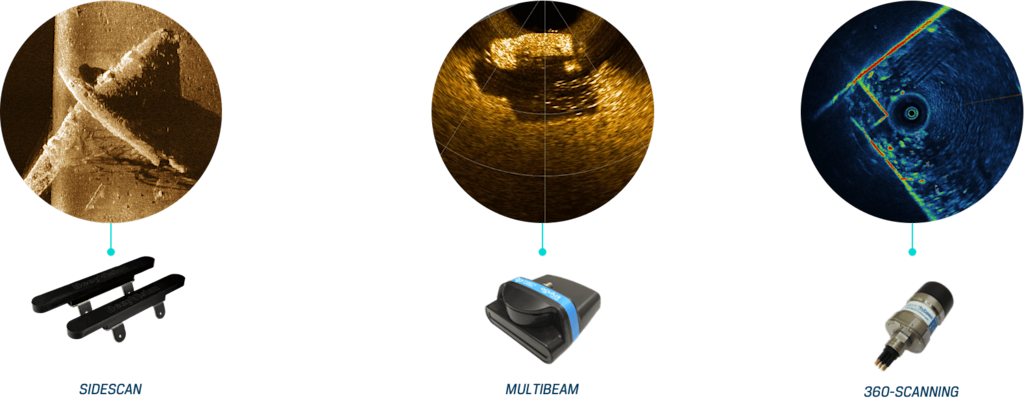From PX to X3
The first Blueye prototype, the PX, went into the water in November 2015, and we launched our first product, the Blueye Pioneer, in the market in December 2018. At the beginning of 2020, the Blueye Pro improved on the Pioneer with an increased depth rating, a camera with better optics, and mechanical tilt.

Since the beginning, we have kept the design principle of the vehicle's general shape the same. The slim, vertical, and upright body ensure important hydrodynamic and hydrostatic properties. The tether is attached close to the center of gravity to minimize unwanted pitch motion due to tether drag. With surge thrusters placed in front of the tether attachment point, the ROV can still turn freely even while experiencing tether drag. The buoyancy is placed at the top of the body, while the battery and ballast weights are at the bottom, making the mini ROV self-balancing. The fins running along the side of the vehicle dampens any roll motion. The slender profile cuts through the water with minimum drag.
All of the above design principles help ensure the most stable, user-friendly, and intuitive control experience of any mini ROV.
Over the last two years, we have also released several software updates to the Blueye App and Blunux operating system adding new functionality such as report generation, video overlays with custom logos, image stabilization, ability to share footage in Microsoft Teams, and many other improvements.
These updates are free for all Pioneer and Pro customers and an example of how the value of a Blueye purchase increase over time.
Now we are ready to launch our third model: the Blueye X3!
Beginning of a new era
In one way, does the X3 mark the end of a chapter for Blueye.
We have now delivered our original vision for the product and created what we believe is the most user-friendly, robust, versatile, and expandable mini ROV in the market.
However, the X3 is also the beginning of a new chapter. Three guest ports, combined with our user-upgradable Blunux operating system, open up endless possibilities for integrating external peripherals such as sonars, manipulators, sensors, cameras, or lights.
Hardware improvements
The three guest ports offer three multiple power levels and eight different communication protocols. Through the USB connection, we can also add new protocols in the future.
These connectivity options make the X3 prepared for all kinds of underwater equipment used in the industry today and in the future.

In addition to the guest ports, the X3 comes with 256 GB of storage, four times the capacity of our previous models.
We have improved the camera with a larger image sensor for better image quality in murky waters and low light conditions.
To the aluminum backbone, we have added a new strong point for robustly mounting external payloads.
Blueye External Camera
One peripheral we have developed for the X3 to take advantage of the new guest port is the Blueye External Camera.
It uses the same high-quality camera found in our Blueye Pro drones packaged into a tiny waterproof enclosure.
The camera can be mounted in numerous ways depending on your use case, and you will be able to view both the primary camera and the external camera simultaneously.
You can point it straight up to inspect the hull of a flat bottom boat, or you can mount it pointing backward to get better spatial awareness when accessing tight spaces.

Our software team has developed tight integration of the Blueye External Camera with the Blunux operating system, the Blueye App, and the Observer app.
The drone operator can easily switch between the primary camera and the external camera using touch or the physical controller.
The drone will record video and capture still pictures from both cameras at the same time.

Blueye External Lights
To complement the new camera, we have created the Blueye External Light. If you choose to mount the camera in a different direction, the lights will ensure you get the light you need for the external camera.
Lights are controlled directly from the app, setting the intensity of both the primary light and the external light.
The lights can also be used independently of the external camera to get extra light when operating in the dark, allowing you to get an even better overview from a greater distance.
The external light adds a total of 3000-lumens intensity, giving you 6300 lumens together with the primary light, or close to 10.000 lumens if used in a pair.

Grippers
The X3 does not only allow for the connection of Blueye peripherals. It opens up the drone as a platform for a range of third-party equipment.
A frequent request, particularly from our customers in aquaculture, is for a gripper to allow them to recover lost items in the fish pen.
With the X3, we now offer two alternatives: the Newton gripper from BlueRobotics, or the more advanced two-axis Reach Alpha gripper from Blueprint Lab.
Both grippers are fully integrated with the Blueye app, giving you complete control using the trigger buttons on the controller to open and close the grip.

Sonars
Sometimes you need to see beyond what the camera can capture on its own. Murky waters and poor visibility can sometimes limit your range of sight to only a meter or two. A sonar will allow you to see much further, greatly helping you navigate and find your way underwater.

On the left, you can see a scan of the Short Sunderland wreck found here in the Trondheim fjord, captured using a side-scan sonar mounted on an X3 drone.
To the right, you can see the outline of a small wreck captured from more than 30 meters distance using multibeam sonar.

The ISS360 sonar from Impact Subsea is the most compact imaging sonar in the world. It offers excellent image clarity, 360 fields of view, and up to 90 meters range and integrates nicely with the Blueye X3.
Positioning Systems
Another tool that can help with underwater navigation and tracking is positioning systems.
Traditional GPS does not work underwater, as the signals cannot penetrate the surface. To get the position of the drone underwater, you need to add an acoustic positioning system.
Blueye will add support for positioning systems to the Blunux operating system later this year. The positional data will be added to pictures and videos as metadata, stored as part of the dive log, and made available through the app in various formats similar to how you can generate dive reports today.
You will also be able to see the drone location on a map in the Blueye App.
WaterLinked G2 and DVL
We are working closely with WaterLinked, another Trondheim-based underwater technology company, to add support for their Underwater GPS G2 positioning system and A50 Dopler Velocity log.
For the X3, the A50 DVL will give the drone information about speed, direction, and altitude over the seabed, enhancing the accuracy of the positioning system and enabling new control modes such as position-hold, distance-hold, altitude-hold, or automatic navigation to predefined waypoints.
The WaterLinked U1 locator is battery-powered, making it possible to use it on all existing Blueye Pioneer and Pro drones.

Surface Unit 2nd generation
The X3 will be delivered with our 2nd generation Surface Unit. We have greatly improved the robustness of the Surface Unit by switching to a waterproof USB-C connector, protected by an improved water cover.
We have moved the antennas inside the enclosure to remove the risk of damaging or breaking these. The communication module on both the X3 and Surface Unit sides has been updated, ensuring a more robust connection over longer tethers.
The Surface Unit provides a Wi-Fi connection to the drone for mobile devices or computers. When connecting an ethernet-based peripheral, such as a multibeam sonar, the operator can connect his laptop wirelessly to the drone to view and record the sonar images.
The 2nd generation Surface Unit is compatible with existing Blueye Pioneer and Pro drones.

High Capacity Battery
As our customers experience the benefits of conducting more frequent underwater inspections, they feel the need to operate longer in one charge.
Our fully certified Blueye Smart Battery is 96.2 Wh and within the requirements for air travel and a massive benefit for our customers who frequently travel with their drones.
To meet the needs of customers who wish to operate longer, we are developing a high-capacity battery pack that will more than double the operation time of the drone to 5 hours.
The battery will be available towards the end of Q4 and is compatible with existing Blueye Pioneer and Pro drones.
Xbox Controller
Our decision to operate our drones from standard iOS or Android devices is rooted in a strategy and vision where the Blueye App is part of a broader mobile ecosystem.
Sharing live footage from the Blueye drone in Microsoft Teams is one example of such integrations.
Another benefit is that you can take advantage of the latest innovations in mobile device hardware, with faster processors, better and brighter screens, or the newest game controllers.
For the X3, the new default controller option will be the latest Xbox controller. This high-quality controller supports iOS and Android devices and can be used wirelessly over Bluetooth or a wired USB connection.
These controllers are also and easy to find in case you ever need a replacement.

Summary
The X3 launch marks both the end of a chapter and the beginning of a new one for Blueye. With the X3, we deliver on our vision for the user-friendly, robust, versatile, and expandable mini ROV in the market.
Our focus going forward will be to expand on the capabilities of the X3 with support for more peripherals, not only by simply attaching them to the drone but by ensuing maximum value and the best possible user experience through deep software integration with both the Blunux operating system and the Blueye App.
